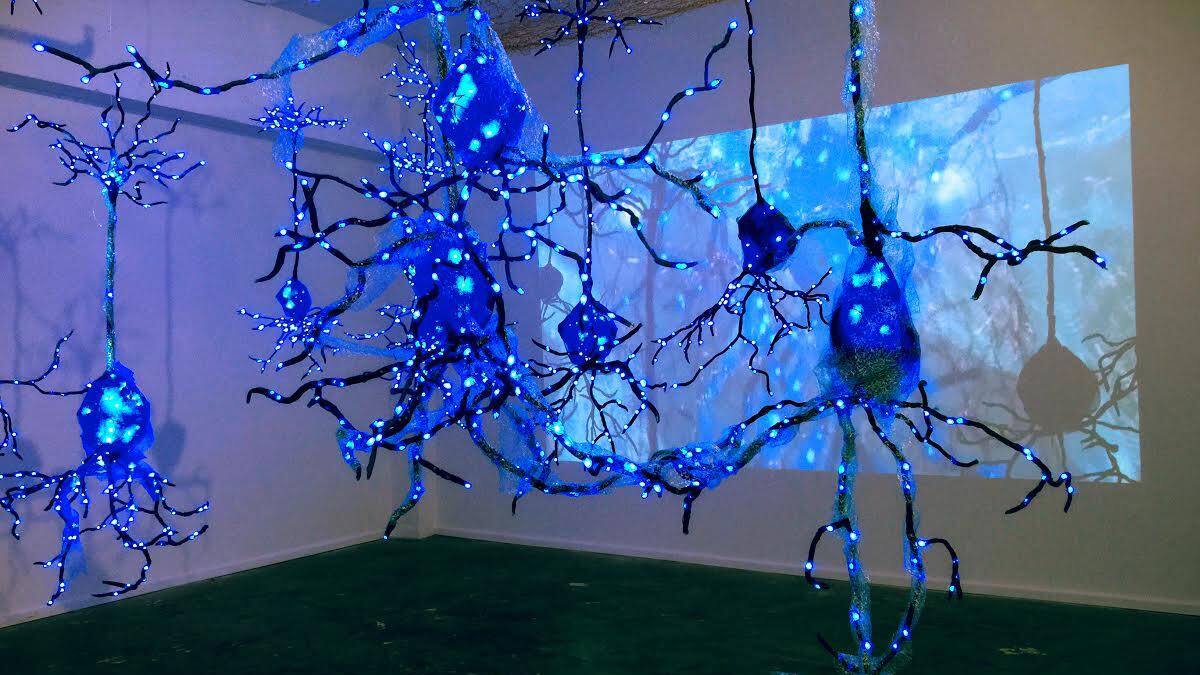Two years ago, a Washington State neuroscientist named John Harkness began to solve a mystery that had been stagnant for over a century. Around some of the hundreds of billions of neurons in a human brain, there's a net-like membrane called a perineuronal net. The membrane was discovered in the late 1800s, but its purpose was such a mystery that its existence was basically ignored until just a few years ago when scientists began to comprehend the effect perineuronal nets have on a brain's longevity. Harkness was among those scientists. In 2015, his WSU lab released a study that suggested the nets are responsible for storing long-term memories.
It's for that research that Harkness is credited as a co-creator of Illuminated Wilderness: Memory, Portland artist Kindra Crick's new installation. Hanging from the ceiling in a corner of Littman Gallery is a series of fabric and wire sculptures shaped like giant neurons. They're dotted with blue LED lights in their core that illuminate the dark gallery, and wrapped in wide mesh that represents the perineuronal nets.
But to the casual viewer, the netting is as inconsequential as it was to scientists in the century before Harkness' discovery. There's no mention of perineuronal nets in the gallery, and no explanation of what Harkness actually did. The only hint is a caption to a video of up-close shots of the neuron sculptures projected at the back of the room: "Inspired by groundbreaking research in memory and addiction."
Instead of any further explanation, there's a quote on the wall by the Austrian neuroscientist Eric Kandel: "Has it ever struck you that life is all memory, except for the one present moment that goes by you so quickly you hardly catch it going?" Clearly, Illuminated Wilderness isn't simply a lecture on Harkness' discovery.
A smaller version of the project premiered at the NW Noggin neuroscience and art festival in 2016. Then, it was one piece in a group exhibit, and a collection of smaller neuron sculptures confined inside a single, copper-wire column. But this time, Crick has the gallery to herself. Each sculpture is several feet long and individually suspended from the gallery ceiling. They resemble roots as much as constellations. You can walk between the sculptures, like it's some kind of floating forest.
There are also prints that Crick created during her recent residency at Sitka Center for Art and Ecology outside of Lincoln City, and glass bottles that contain objects from nature, like sand and moss-covered sticks. One of the prints, "Cerebral Wilderness," is a visual pun on the neuron installation—a black-and-white image of neurons that look like trees growing from the ground.
Crick's career-long exploration of how science intersects with art has often placed her within the sci-art movement. Still in its infancy, the movement aims to reconcile what it sees as two disciplines that are at odds with one another—evidence-based science and expressive art. SciArt magazine, which was founded less than five years ago, frequently features Crick's work.
Often, sci-art strangles itself with its own ideology. But for Crick, it's personal: her grandmother was the painter Odile Crick, and her grandfather was one of the most famous biologists of all time, Francis Crick, who discovered the double-helix structure of DNA.
In Illuminated Wilderness, Crick's stance on where art meets science seems concise. She's interested in the wonder produced by discovery, regardless of whether it was achieved by an empirical or an emotional investigation. Walking through the giant, glowing neurons is ethereal. If you know the story behind them, maybe the installation will inspire awe at the microscopic complexity they represent. If you don't, that's fine too—the sculptures are plenty awe-inspiring on their own.
Visually, the neuron sculptures are the highlight of the exhibit. But the clearest example of Crick's philosophy is hand-written on a scrap of paper displayed on the gallery wall. On a shelf along one of the gallery walls are four glass jars containing bits of nature that Crick collected from the Oregon Coast. Behind each specimen is a scrap of paper covered in hand-written notes. They like look like something out of a field journal, but they read more like diary entries. Behind a jar of rocks and sand, she writes about a noise the sand made as she dragged her canoe into the water. "It squeaked," she writes, underlined and in all caps. "How shocking, amazing and wonderful."
It's that amazement of how much there is to discover that Illuminated Wilderness seems concerned with. It's not the insights that any given exploration leads to, but the thrill of noticing anything in the world you hadn't noticed before.
SEE IT: Illuminated Wilderness: Memory is at PSU's Littman Gallery, 1825 SW Broadway, facebook.com/littmanandwhite. Through Feb. 2. Opening reception 5-8 pm Wednesday, Jan. 17.
